
The name destroying angel applies to several similar, closely related species of deadly all-white mushrooms in the genus Amanita. They are Amanita virosa in Europe and A. bisporigera and A. ocreata in eastern and western North America, respectively. Another European species of Amanita referred to as the destroying angel, Amanita verna - also referred to as the 'Fool's mushroom' - was first described in France in 1780.
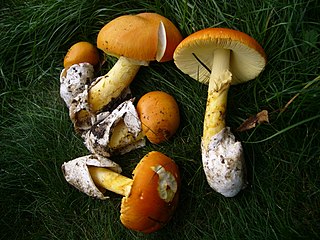
Amanita caesarea, commonly known as Caesar's mushroom, is a highly regarded edible mushroom in the genus Amanita, native to southern Europe and North Africa. While it was first described by Giovanni Antonio Scopoli in 1772, this mushroom was a known favorite of early rulers of the Roman Empire.

Amanita ocreata, commonly known as the death angel, destroying angel, angel of death or more precisely western North American destroying angel, is a deadly poisonous basidiomycete fungus, one of many in the genus Amanita. The large fruiting bodies generally appear in spring; the cap may be white or ochre and often develops a brownish centre, while the stipe, ring, gill and volva are all white. A. ocreata resemble several edible species commonly consumed by humans, increasing the risk of accidental poisoning. Mature fruiting bodies can be confused with the edible A. velosa, A. lanei or Volvopluteus gloiocephalus, while immature specimens may be difficult to distinguish from edible Agaricus mushrooms or puffballs.
Amanita altipes, also called the yellow long-stem amanita, is a species of agaric fungus found in coniferous woodlands in southwestern China.

Amanita brunnescens, also known as the brown American star-footed amanita or cleft-footed amanita is a native North American mushroom of the large genus Amanita. It differs from A. phalloides by its fragile volva and tendency to bruise brown.
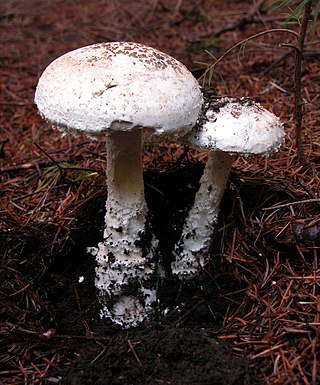
Amanita smithiana, also known as Smith's amanita, is a species of agaric found on soil in coniferous and broadleaved woodland in the Pacific Northwest of North America. It fruits in August and September.
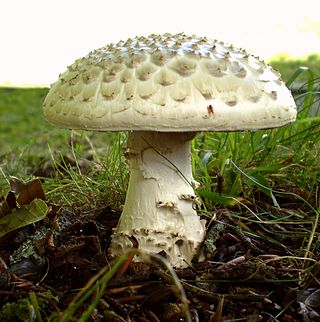
Amanita echinocephala is a large, whitish or ivory-coloured mushroom with a characteristic spiny, or warty-looking cap. A. solitaria is a synonym and opinions are divided as to which name takes precedence. It lives on chalky soils with beech trees, and appears earlier than most mushrooms of similar size in southern England. It frequently occurs singly or in small groups, resulting in it being referred to as the solitary amanita or, more specifically, European solitary lepidella. It is very drought-tolerant.

Agaricus pattersoniae is an edible species of mushroom. It is found in the United States, where it associates with cypress trees. It has been proposed for inclusion in the IUCN Red List of Threatened Species.

Amanita persicina, commonly known as the peach-colored fly agaric, is a basidiomycete fungus of the genus Amanita with a peach-colored center. Until c. 2015, the fungus was believed to be a variety of A. muscaria.

Amanita flavoconia, commonly known as yellow patches, yellow wart, orange amanita, yellow-dust amanita or the American yellow dust amanita, is a species of mushroom in the family Amanitaceae. It has an orangish-yellow cap with yellowish-orange patches or warts, a yellowish-orange annulus, and a white to orange stem. Common and widespread throughout eastern North America, A. flavoconia grows on the ground in broad-leaved and mixed forests, especially in mycorrhizal association with hemlock.

Amanita daucipes is a species of fungus in the family Amanitaceae of the mushroom order Agaricales. Found exclusively in North America, the mushroom may be recognized in the field by the medium to large white caps with pale orange tints, and the dense covering of pale orange or reddish-brown powdery conical warts on the cap surface. The mushroom also has a characteristic large bulb at the base of its stem with a blunt short rooting base, whose shape is suggestive of the common names carrot-footed lepidella, carrot-foot amanita, or turnip-foot amanita. The mushroom has a strong odor that has been described variously as "sweet and nauseous", or compared to an old ham bone, or soap. Edibility is unknown for the species, but consumption is generally not recommended due its position in the Amanita subgroup Lepidella, which contains some poisonous members.

Amanita onusta, commonly known as the loaded Lepidella, the gunpowder Lepidella or the gunpowder amanita, is a species of fungus in the mushroom family Amanitaceae. It is characterized by its small to medium-sized fruit bodies that have white to pale gray caps crowded with roughly conical, pyramidal, or irregular gray warts. The stipe is whitish-gray with woolly or wart-like veil remnants, and at the base is a spindle- or turnip-shaped base that is rooted somewhat deeply in the soil.
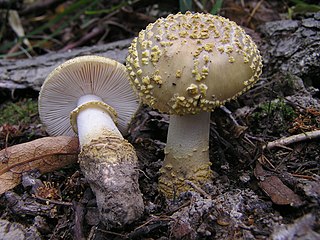
Amanita franchetii, also known as the yellow veiled amanita, or Franchet's amanita, is a species of fungus in the family Amanitaceae.

Amanita atkinsoniana, also known as the Atkinson's amanita, is a species of fungus in the family Amanitaceae. The fruit body is white to brownish, with caps up to 12.5 centimetres in diameter, and stems up to 20 cm long. The surface of the cap is covered with brownish conical warts.

Amanita ravenelii, commonly known as the pinecone lepidella, is a species of fungus in the family Amanitaceae. The whitish fruit bodies are medium to large, with caps up to 17 centimetres wide, and stems up to 25 cm (10 in) long. The cap surface has large warts and the stem has a scaly, bulbous base. The mushrooms have a unique chlorine like odor.
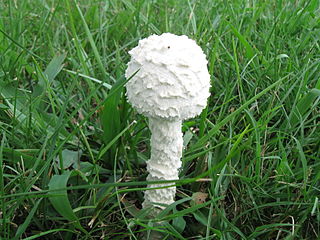
Saproamanita thiersii, commonly called Thiers' lepidella, is a North American saprotrophic basidiomycete fungus in the genus Saproamanita. It is a white, small mushroom. Its cap is convex, measuring 3.5–10 centimetres across, and the stipe is 8–20 cm (3–8 in) long. The spore print is white.

Amanita frostiana, also known as Frost's amanita, is a small yellow-to-red fungus found in eastern North America.
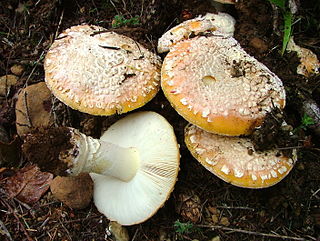
Amanita aprica, also known as the sunshine amanita, is a toxic species of fungus in the family Amanitaceae.

Amanita augusta is a small tannish-brown mushroom with cap colors bright yellow to dark brown and various combinations of the two colors. The mushroom is often recognizable by the fragmented yellow remnants of the universal veil. This mushroom grows year-round in the Pacific Northwest but fruiting tends to occur in late fall to mid-winter. The fungus grows in an ectomycorrhizal relationship with hardwoods and conifers often in mixed woodlands.

Amanita ananiceps is a species of agaric fungus in the family Amanitaceae native to Australia.




















